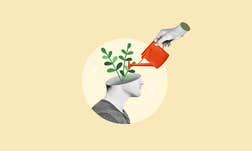Under a coral ledge, a day octopus and a brown-marbled grouper meet. The grouper was there first, as if waiting, and they emerge together; the octopus zips ahead, skin turning from deep scarlet to purple-blue, and arrives at a boulder. Beneath the boulder is a hollow, a perfect hiding place for small prey. The octopus’s skin flickers and momentarily resembles the grouper’s own mottled scales before reverting to blue. They converge side-by-side in front of the hollow, seeming to consider it.
Again the octopus’ skin mottles, and then again, the second time not much resembling the grouper’s patterns but rather a constellation of lights. The octopus swims to the boulder’s far side and makes a barrier with tentacles now spread flat and turned white. The grouper dives into the hollow, looking for fish whose escape routes have been blocked. Never mind the 500-million-year taxonomic gulf that separates them. Hunger, opportunity, and smarts cross that divide easily, hinting at adaptations that could help these unlikely partners navigate lean years ahead and providing an interspecies union to tickle human imaginations.
“Crossing a phylum gap like this is almost like a human talking to a snail,” says Daniel Bayley, a marine biologist at University College London. “It’s amazing to watch.” Bayley and Amelia Rose of Oxford University observed octopuses working with brown-marbled grouper—and with peacock grouper and gold-saddle goatfish, too—in sunlit shallows off atolls in the northern Chagos Archipelago, a remote chain of islands in the Indian Ocean. The incidents caught their attention: While multispecies associations are not uncommon in the animal kingdom, it’s unusual to see such them between such different creatures. What’s more, this was a true collaboration.
The animals were not merely taking advantage of the other’s activities, as happens when fish follow turtles across the seafloor, snapping up critters scattered by their sediment-disturbing foraging. They actively communicated with one another—not unlike the coyote and badger who starred in a viral video last year, with the coyote making a distinctive canine play bow to invite the badger along. There’s a lot of cognitive sophistication packed into such interactions.
That octopuses would be involved is likely no surprise for people attuned to a cephalopod-celebrating zeitgeist inspired by books like Sy Montgomery’s best-selling The Soul of an Octopus and the wildly popular documentary My Octopus Teacher, which showed marvelous behaviors that had yet to be described scientifically: an octopus camouflaging herself with seashells, or playing with schools of fish. Popular footage likewise preceded description with octopus-grouper unions featured in the Blue Planet II television series and in a handful of YouTube videos. In the Chagos Archipelago, though, Bayley and Rose had the chance to observe the collaborations in detail.
If you think about it, that’s like us speaking to fish.
As they recount in a study published in the journal Marine and Freshwater Behaviour and Physiology, the researchers even started to decipher some of the signals. When octopuses preceded the hunt with what Bayley and Rose called a “pounce” gesture, engulfing corals with their mantle and turning white, it was their fish partners who ate. When instead octopuses made a “groping” gesture, inserting tentacles into a crack or crevice, it was their turn to dine. “It was very much a give-and-take scenario,” Bayley said. Other gestures and skin-pattern signals remain uninterpreted. (Bayley and Rose did not observe octopuses “punching” their partners, as another team of researchers recently documented in the Red Sea.)
Asked to review the footage, Culum Brown, a behavioral ecologist at Macquarie University who specializes in fish intelligence, said “they are clearly communicating with one another.” Brown, who agrees that the hunts are planned, is curious how about how they’re initiated. Do octopuses give the go-ahead? Or fish? And how are partners chosen? Brown pointed to research on groupers cooperating with moray eels to hunt. Those fish select the most competent eels, demonstrating a collaborative sophistication once thought limited to humans and certain primates. He also noted that, while octopuses seemed to take the lead, the collaborations seen by Bayley and Rose demand quite a bit of intelligence from the fish as well.
Bayley’s own specialty is coral reef ecology, and his curiosity is piqued by what the cooperation represents. Though scientists have studied the Chagos Archipelago for decades, he said, no record exists of octopuses and fish hunting together there. He suspects it’s a recent adaptation. In the last several years, climate change-induced coral die-offs have radically disrupted the reefs’ animal populations and changed their very topography. There is much less prey than before; fields of rubble are not ideal for ambush-style hunting tactics that once worked so well.
“This could be driving this novel interaction where both fish and octopus are searching for food, but their individual hunting strategies are not best for this flattened environment that’s losing a lot of its structure,” Bayley explained. Partnerships with gold-saddle goatfish are also notable in that they are adapted to find prey buried in sediment. “It’s another skill set to bring in. It’s almost like the octopus is assembling a team with specialist skills,” said Bayley.
Another fascinating question, he said, is how knowledge spreads of hunting strategies and mutually understood signals. Perhaps each participating octopus and fish works it out for themselves, through trial and error—or perhaps, following an initial breakthrough, knowledge spreads by observation or even active teaching. That would make it a cultural adaptation, a matter of accumulating knowledge passed between generations, an example of species surviving in a fast-changing world not because of some fortunate genetic mutation but because they are learning. This also suggests a potentially key role for grouper. Unlike day octopuses, who reach a ripe old age at 15 months, brown-marbled and peacock grouper can easily live 40 years or longer. They may be a living library for their short-lived partners.
That the Chagos Archipelago is so remote and well-protected—commercial fishing is banned there—may also help these underwater cultures evolve and proliferate, Bayley said. Individuals who would otherwise spread their knowledge don’t end up on a dinner plate. Brown agreed, noting an emerging scientific literature on the importance of animal culture to conservation and also the hypothesis that a loss of culture has hindered the recovery of some populations from overfishing. “One of the explanations is that we’ve basically fished out the cultural information about where to forage, where to migrate, where the best breeding grounds are,” he said. “If you’re consistently removing the biggest, the oldest and wisest, from the population, then that information is lost.”
That understanding adds new importance to halting overfishing, and also to curbing pollution and excessive underwater noise that can impair learning, in other parts of the ocean—and maybe the sheer wonder of watching octopuses and fish work together can help inspire people to take action. Brown, echoing Bayley, marveled at the cross-phylum communication. “If you think about it, that’s like us speaking to fish,” said Brown, who could not think of an example of humans communicating in such a sophisticated manner with either fish or cephalopods. The closest analogue is people and their dogs. “It’s pretty astonishing,” he said.
Brandon Keim (Twitter / Instagram) is a science and nature journalist. He is presently working on Meet the Neighbors, a book about what understanding the minds of animals means for human relations to wild animals and to nature.
Research by Daniel Bayley was funded by the Bertarelli Foundation. You can find out more about its marine science program here.
Lead art: ezumer / Shutterstock
This article was originally published on our Oceans Channel, in January 2021.


























